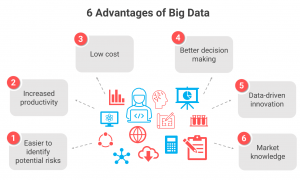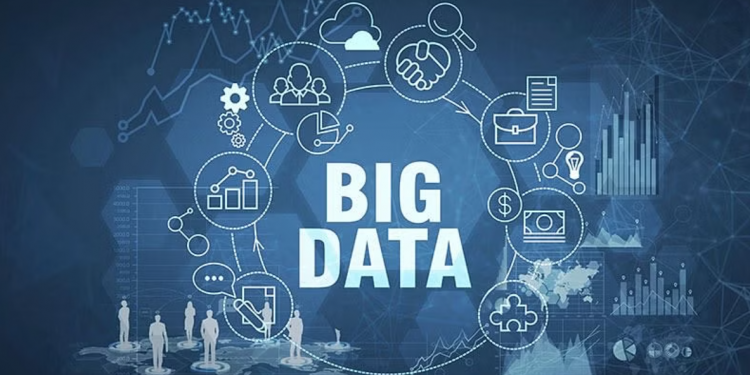The term “Big Data” has proliferated in the era of digital transformation, and its significance for enterprises cannot be overstated. For organizations of all sizes and in all industries, the gathering, processing, and analysis of massive volumes of data have become crucial steps in the decision-making process.
What is Big Data?
Big Data is the term used to describe the enormous volume of organized and unstructured data that businesses gather every day. Social media, customer reviews, sales statistics, web traffic, and other sources are just a few of the places where this information can be found. The “3Vs” – volume, velocity, and variety – define big data. Volume, velocity, and variety all refer to the sheer volume of data being collected, while Velocity is the rate at which the data is generated and processed, and Variety is the kind of data being collected.
What are the 3 types of big data?
In general, Big Data can be classified into three types, based on the nature of the data and how it is processed. These three types of Big Data are:

- Structured Data: Structured data refers to data that is organized in a specific format and can be easily stored, searched, and analyzed using traditional relational databases. Structured data is typically quantitative and can be easily analyzed using tools like SQL or Excel. Examples of structured data include financial data, customer transaction data, and inventory data.
- Unstructured Data: Unstructured data refers to data that does not have a specific format and is not easily organized or analyzed using traditional databases. Unstructured data is typically qualitative and can include text, images, audio, and video files. Examples of unstructured data include social media posts, emails, customer feedback, and video footage.
- Semi-structured Data: Semi-structured data refers to data that has some structure but is not organized in a traditional format like structured data. Semi-structured data is often used in Big Data applications, such as web logs and sensor data. Examples of semi-structured data include XML and JSON files.
What are the advantages of Big Data?
Big Data offers numerous advantages to organizations that can harness its power. Here are some of the key advantages of Big Data:
- Improved Decision Making: Big Data enables organizations to make better, data-driven decisions. By analyzing large amounts of data, organizations can gain valuable insights into customer behavior, market trends, and other factors that can inform strategic decision-making.
- Enhanced Customer Insights: Big Data allows organizations to gain a deeper understanding of their customers. By analyzing customer data, organizations can identify patterns and trends that can inform product development, marketing campaigns, and other customer-facing initiatives.
- Operational Efficiency: Big Data can help organizations optimize their operations and improve efficiency. By analyzing production data, supply chain data, and logistics data, organizations can identify areas for improvement and implement changes that can result in significant cost savings.
- Improved Risk Management: Big Data can help organizations identify and manage risk more effectively. By analyzing financial data, insurance claims data and other data sources, organizations can identify potential risks and take steps to mitigate them.

- Competitive Advantage: Big Data can provide organizations with a significant competitive advantage. By leveraging data to make better decisions, organizations can outmaneuver competitors and gain market share.
- Innovation: Big Data can drive innovation by providing organizations with new insights and ideas. By analyzing data from a variety of sources, organizations can identify new product and service opportunities and develop innovative solutions to complex problems.
- Personalization: Big Data can help organizations personalize their products and services to meet the specific needs and preferences of individual customers. By analyzing customer data, organizations can identify individual preferences and tailor their offerings accordingly.
Overall, Big Data offers numerous advantages to organizations that can successfully harness its power. By leveraging the insights that Big Data provides, organizations can make more informed decisions, improve efficiency, manage risk more effectively, and gain a significant competitive advantage.
The Role of Big Data in Business
Big Data is the term used to describe the enormous volume of organized and unstructured data that businesses gather every day. Social media, customer reviews, sales statistics, web traffic, and other sources are just a few of the places where this information can be found. The “3Vs” – volume, velocity, and variety – define big data. Volume, velocity, and variety all refer to the sheer volume of data being collected, while Velocity is the rate at which the data is generated and processed, and Variety is the kind of data being collected.
Lastly, Big Data has made it possible for businesses to make more informed strategic choices. Organizations can make better judgments regarding product development, market expansion, and other strategic activities by examining market trends, competitive data, and other external factors.
The Role of Big Data in Decision-Making Processes
The decision-making process has been significantly impacted by big data as well. Decisions were frequently made in the past based on intuition and experience. But now that Big Data is accessible, businesses may make more data-driven choices.
Big Data helps businesses to quickly and effectively analyze massive volumes of data, giving decision-makers the knowledge they need to make wise choices. Organizations can, for instance, determine which items are the most popular and which features are the most significant to customers by analyzing customer data. Using this knowledge, decisions about product development and marketing can be made with more knowledge.
Organizations can also use big data to perform predictive analytics, which uses data to forecast future results. Organizations can forecast future product demand, for instance, and modify their production and supply chain accordingly by analyzing sales data and market trends.
Conclusion
Big Data is now an essential component of how companies run and how choices are made. By collecting and analyzing vast volumes of data, businesses may gain unparalleled insights into the behavior of their customers, enhance their operations, and make more informed strategic decisions. Additionally, big data gives firms the ability to make more data-driven decisions, which can improve results and increase competitiveness. The importance of big data will increase as our economy transitions to a data-driven one.

